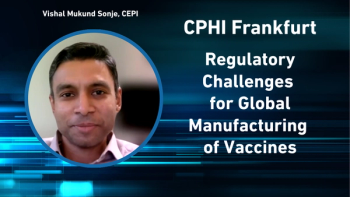
- Pharmaceutical Technology-12-02-2018
- Volume 42
- Issue 12
Going Beyond the Surface to Ensure Supplier Quality
Success depends on supplier communication and transparency, but it’s up to buyers to demand the right information and to look at the vendor’s overall business goals.
As niched global markets grow and increase the complexity of pharmaceutical manufacturing, vendor management has become more challenging; the API and excipient supplier base has moved offshore, and more core operations are being outsourced to contract partners. Today, a typical pharmaceutical manufacturer works with 100–200 contract manufacturing organizations (CMOs) (1). A 2013 study found that supply and supplier issues account for 40% of the pharmaceutical industry’s top supply-chain risks (2).
Adding to the difficulty have been corporate mergers and acquisitions, both on the manufacturer and on the supplier sides. Mergers shift the focus away from manufacturing, as Steve Cottrell, president of Maetrics, wrote in April 2018 in the PharmaPhorum blog (3). This, in turn, limits “the ease with which supply chain gap analyses, supplier assessments, and quality assurance checks (e.g., non-conformance or out-of-stock issues) can be carried out,” he wrote.
The results have been clearly seen in an increase in drug shortages, recalls, and regulatory citations for insufficient quality management and vendor oversight. Overall, supply reliability issues cost biopharmaceutical companies $2 billion in revenue each year, according to the Boston Consulting Group (4). Pharmaceutical manufacturers still have limited visibility into their supply chains, and fairly loose, ad hoc connections with many of their vendors, in sharp contrast to the close supplier-manufacturer partnerships and data exchange programs that exist in the automotive, aerospace, and electronics industries.
Industry efforts
Manufacturers have been working individually and in concert to address these issues, through initiatives such as the Pharmaceutical Supply Chain Initiative (PSCI), a group of 33 manufacturers that has developed best practices, self-assessment guidelines, and an audit protocol based on the principles of sustainable sourcing and traceability, transparency, business resilience, and management capability and systems.
The organization, which started up in 2005 with five members, has trained 190 auditors and 150 staffers at pharmaceutical industry suppliers in best practices and principles and is promoting the concept of shared supplier audits to reduce costs for manufacturers and their suppliers. The number of shared PSCI audits more than doubled from 61 in 2016 to 152 in 2017, according to Enric Bosch Radó, a manager in Boehringer-Ingelheim’s environmental health and safety department, who presented a progress report at Salon International de la Logistique (SIL), the international logistics meeting in Barcelona on June 5, 2018 (5).
Real-time data exchange and trust
BioPhorum, a collaborative industry effort, is working on a blueprint for 21st century supply chain management as part of its Technology Roadmap program. Newer technologies, such as single-use systems for cell culture, Protein A, and chromatographic resins, require a significant investment from biopharmaceutical manufacturers, according to the group’s latest report (6), while the cost of poor quality (evident in raw material variability and lack of understanding and control of the supply chain) is high and must be driven out. Close collaboration between manufacturers and vendors will be increasingly important for ensuring supplies of single-use technologies, and as more companies evaluate continuous bioprocessing, said Jonathan Haigh, head of downstream processing at FujiFilm Diosynth, a company that is both a manufacturer and a contract manufacturer, in a video (7) discussing roadmapping efforts. BioPhorum has called for changing the way manufacturers and vendors interact, and to promote harmonized methods using electronic data exchange. The group is also working on improving forecasting and planning software.
Sharing best practices
One method that suppliers and their customers are using to attempt to balance rapid growth in demand and the need for careful planning is the sales and operational planning process, which examines inventory replenishment and distribution needs, and assesses manufacturing, including manufacturing and quality equipment and warehousing and how well it can support customer requirements, said Aida Tsouroukdissian, head of demand planning at MilliporeSigma in a 2018 video (8). Other methods being used include supply chain business continuity planning and supply chain mapping as well as change management.
There is a need to go beyond the superficial level, noted Roger Estrella, senior risk manager for supplier business continuity at Genentech, in an Rx-360 workshop addressing challenges in the pharmaceutical raw material supplier chain (9). Estrella’s business continuity group works closely with Roche’s corporate quality risk organization, which handles audits, recalls and customer complaints, and process capability to be able to respond to and find the root cause of quality issues. Roche analyzes suppliers based on their potential impact on the business and the patient. The first question is what would happen to patients if there were a problem with the supply of this particular product? What impact would a supply interruption have on revenues and on patients? Materials are classified based on level of risk (e.g., oncology products would be placed in a higher category of risk than treatments for rheumatology), he said.
Manufacturers must identify hazardous conditions, assess risks and develop contingency plans, get them approved and then implement them. Challenges to asserting full control over supply chains include cognitive bias, supply chain complexity, and business change management, Estrella said. Too often, employees may tend to discount risks, especially those that may occur in the future, he said, adding that strengthening supplier risk assessment requires a top-down approach and senior-level management support if it is to succeed. He said that, wherever possible, Roche avoids being dependent on overseas suppliers.
Going beyond the surface
It is no longer enough for manufacturers to have transparency from most important suppliers; they now need insights into how these suppliers manage their supply chains, Estrella said. Roche asks that suppliers give them some idea of their business continuity management by conducting manufacturing risk assessments at each relevant manufacturing site; developing mitigation plans for each risk; determining worst-case scenarios for the most likely site risks; and estimating the time that it would take for them to return to normal after a supply upset. If suppliers aren’t already doing this, the company helps them with the process and uses results to develop its risk mitigation inventory levels for the particular material, he said.
Manufacturers must also look at each supplier’s business portfolio and ask how each particular product fits into that vendor’s big picture. “Consolidations have complicated the supplier-manufacturer picture. Every time that a merger and acquisition takes place, a rising star product can become a dog, and the new owners may decide not to invest in quality and delivery performance initiatives,” he said. In some cases, the new business owners may even stop making a product that has always been important to the manufacturer’s business, and biopharmaceutical manufacturers must be prepared and develop alternatives. He also noted that a supplier may be critical to an individual biopharmaceutical company’s business, yet biopharmaceutical manufacturing may not be a major market focus for them, so manufacturers should be prepared. In general, he said, manufacturers must know suppliers, and must work to minimize the number of intermediates in the supply chain. “The more handoffs you have, the more potential points of failure,” he said. So if there are handoffs it is essential for manufacturers to know who is involved and how they will handle any situations that may come up.
Stressing the importance of supply chain mapping and risk management, he noted that it is straightforward to identify risk, but challenging to mitigate it. Biopharmaceutical manufacturers must be prepared to understand and communicate more closely with suppliers to prevent quality and supply problems from affecting patients and their bottom line.
References
1. A. Alvarado-Seig, et al., “
,” July 2018.
2. M. Jaberidoost et al., DARU Journal of Pharmaceutical Sciences 21, 69 (2013).
3. S. Cottrell, “Gaining a Clear View of Supply Chain Visibility,” pharmaphorum.com, April 20, 2018, www.pharmaphorum.com/views-analysis-market-access/gaining-clear-view-supply-chain-visibility/.
4. A. Merchant et al., “
5. E.B. Radó, “Creating a Better Supply Chain in the Pharmaceutical Industry: The Pharmaceutical Supply Chain Initiative,” a presentation made at Salon International de la Logistique (SIL) (Barcelona, Spain, 2018).
6. BioPhorum, “Biopharmaceutical Manufacturing Technology Roadmap: Supply Partnership Management,” biophorum.org, December 2017.
7. BioPhorum, “
8. A. Tsouroukdissian, “
9. R. Estrella, “Challenges to Raw Material and Supplier Risk Management,” Rx-360 Workshop, “Addressing Challenges in the Pharmaceutical Raw Material Supply Chain Through Industry Collaboration,” rx360.org, March 13, 2014.
Article Details
Pharmaceutical Technology
Vol. 42, No. 12
December 2018
Pages: 16–17
Citation
When referring to this article, please cite it as A. Shanley, “Going Beyond the Surface to Ensure Supplier Quality," Pharmaceutical Technology 42 (12) 2018.
Articles in this issue
almost 7 years ago
Sterile, Integrated Hood and Mask for Larger Heads and Hairstylesalmost 7 years ago
Scaling Up and Launching Solid-Dosage Drugsalmost 7 years ago
Developing and Manufacturing Transdermal Patchesalmost 7 years ago
Spray Film Provides Alternative to Patchesalmost 7 years ago
Improving Production: How IT, OT, and Quality Can Collaboratealmost 7 years ago
Manufacturing Considerations for Transdermal Delivery Systemsalmost 7 years ago
Investigation Timeliness vs. Thoroughness: Finding the Right Balancealmost 7 years ago
Microbial Identification Strategies for Bioburden Controlalmost 7 years ago
Fighting Bacterial Resistance with Biologicsalmost 7 years ago
The Key Word: QualityNewsletter
Get the essential updates shaping the future of pharma manufacturing and compliance—subscribe today to Pharmaceutical Technology and never miss a breakthrough.





